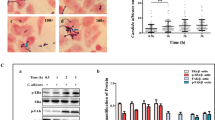Abstract
Purposes
To investigate the early molecular events in oral keratinocytes induced by Candida albicans challenge.
Methods
The oral keratinocyte cell line, Tca8113, was used to study the molecular events induced by C. albicans challenge in oral keratinocytes. The phosphorylation statuses of extracellular signal-regulated protein kinase (ERK) and focal adhesion kinase (FAK) upon C. albicans challenge were assessed using specific antibodies and western blotting. Specific inhibitors for ERK and FAK were used to validate the involvement of ERK-FAK signaling cascade. A Transwell insert system-based migration study was performed to evaluate the involvement of the C. albicans-dependent ERK-FAK activation with cell migration.
Results
Following the stimulation with C. albicans, a transient activation of ERK was observed, which reached a peak at 10 min post stimulation. Similarly, a transient activation of FAK, the downstream substrate of ERK, was also observed upon C. albicans challenges, which reach the maximum at 20 min. Specific inhibitors for ERK and FAK abolished the C. albicans-induced ERK and FAK activations. The elevated migratory ability of oral keratinocyte was observed upon stimulation with C. albicans, and was synchronous with the ERK-FAK activation.
Conclusion
ERK-FAK signaling cascades are involved in the early interaction between the oral keratinocytes and C. albicans, which appears to be linked with the enhanced cell migration.



Similar content being viewed by others
References
Lilly EA, Leigh JE, Joseph SH, et al. Candida-induced oral epithelial cell responses. Mycopathologia. 2006;162:25–32. doi:10.1007/s11046-006-0036-7.
Samaranayake YH, Dassanayake RS, Cheung BP, et al. Differential phospholipase gene expression by Candida albicans in artificial media and cultured human oral epithelium. APMIS. 2006;114:857–66. doi:10.1111/j.1600-0463.2006.apm_479.x.
Ridley AJ, Schwartz MA, Burridge K, et al. Cell migration: integrating signals from front to back. Science. 2003;302:1704–9. doi:10.1126/science.1092053.
Sandovsky-Losica H, Berdicevsky I, Tsarfaty I. Effect of Candida albicans metabolite(s) on cellular actin. FEMS Microbiol Lett. 2002;215:57–62. doi:10.1111/j.1574-6968.2002.tb11370.x.
Cuevas BD, Abell AN, Witowsky JA, et al. MEKK1 regulates calpain-dependent proteolysis of focal adhesion proteins for rear-end detachment of migrating fibroblasts. EMBO J. 2003;22:3346–55. doi:10.1093/emboj/cdg322.
Johnson GL, Lapadat R. Mitogen-activated protein kinase pathways mediated by ERK, JNK, and p38 protein kinases. Science. 2002;298:1911–2. doi:10.1126/science.1072682.
Hunger-Glaser I, Salazar EP, Sinnett-Smith J, et al. Bombesin, lysophosphatidic acid, and epidermal growth factor rapidly stimulate focal adhesion kinase phosphorylation at Ser–910: requirement for ERK activation. J Biol Chem. 2003;278:22631–43. doi:10.1074/jbc.M210876200.
Sun B, Nishihira J, Yoshiki T, et al. Macrophage migration inhibitory factor promotes tumor invasion and metastasis via the Rho-dependent pathway. Clin Cancer Res. 2005;11:1050–8.
Li S, Guan JL, Chien S. Biochemistry and biomechanics of cell motility. Annu Rev Biomed Eng. 2005;7:105–50. doi:10.1146/annurev.bioeng.7.060804.100340.
Borregaard N, Theilgaard-Mönch K, Cowland JB, et al. Neutrophils and keratinocytes in innate immunity–cooperative actions to provide antimicrobial defense at the right time and place. J Leukoc Biol. 2005;77:439–43. doi:10.1189/jlb.0704381.
Pivarcsi A, Kemény L, Dobozy A. Innate immune functions of the keratinocytes. A review. Acta Microbiol Immunol Hung. 2004;51:303–10. doi:10.1556/AMicr.51.2004.3.8.
Velan B, Bar-Haim E, Zauberman A, et al. Discordance in the effects of Yersinia pestis on the dendritic cell functions manifested by induction of maturation and paralysis of migration. Infect Immun. 2006;74:6365–76. doi:10.1128/IAI.00974-06.
Ato M, Maroof A, Zubairi S, et al. Loss of dendritic cell migration and impaired resistance to Leishmania donovani infection in mice deficient in CCL19 and CCL21. J Immunol. 2006;176:5486–93.
Bosio CM, Goodyear AW, Dow SW. Early interaction of Yersinia pestis with APCs in the lung. J Immunol. 2005;175:6750–6.
Skinner JA, Pilione MR, Shen H, et al. Bordetella type III secretion modulates dendritic cell migration resulting in immunosuppression and bacterial persistence. J Immunol. 2005;175:4647–52.
Hii CS, Stacey K, Moghaddami N, et al. Role of the extracellular signal-regulated protein kinase cascade in human neutrophil killing of Staphylococcus aureus and Candida albicans and in migration. Infect Immun. 1999;67:1297–1302.
Lü FX, Jacobson RS. Oral mucosal immunity and HIV/SIV infection. J Dent Res. 2007;86:216–26.
Zhong B, Jiang K, Gilvary DL. Human neutrophils utilize a Rac/Cdc42-dependent MAPK pathway to direct intracellular granule mobilization toward ingested microbial pathogens. Blood. 2003;101:3240–8. doi:10.1182/blood-2001-12-0180.
Chang F, Steelman LS, Shelton JG, et al. Regulation of cell cycle progression and apoptosis by the Ras/Raf/MEK/ERK pathway (Review). Int J Oncol. 2003;22:469–80.
Acknowledgments
We acknowledge Dr. Xiaofeng Zhou, at the Center for Molecular Biology of Oral Diseases, College of Dentistry, University of Illinois at Chicago, IL, USA, for his contribution to the language revision, and this work was supported in part by grants from the National Science Funds for Talented Professionals of China (No. 30725041), the National Basic Research Program of China (2008CB517307), the National Natural Science Foundation of China (Nos. 30300387, 30471891, 30672323), New Century Talents Support Program of MOE (NCET-04-0865), Specialized Research Fund for the Doctoral Program of Higher Education (No. 20040610077).
Author information
Authors and Affiliations
Corresponding author
Additional information
Jing Shi and Xin Zeng contributed equally to this work.
Rights and permissions
About this article
Cite this article
Shi, J., Zeng, X., Zhou, M. et al. Activation of ERK-FAK Signaling Pathway and Enhancement of Cell Migration Involved in the Early Interaction Between Oral Keratinocytes and Candida albicans . Mycopathologia 167, 1–7 (2009). https://doi.org/10.1007/s11046-008-9142-z
Received:
Accepted:
Published:
Issue Date:
DOI: https://doi.org/10.1007/s11046-008-9142-z




